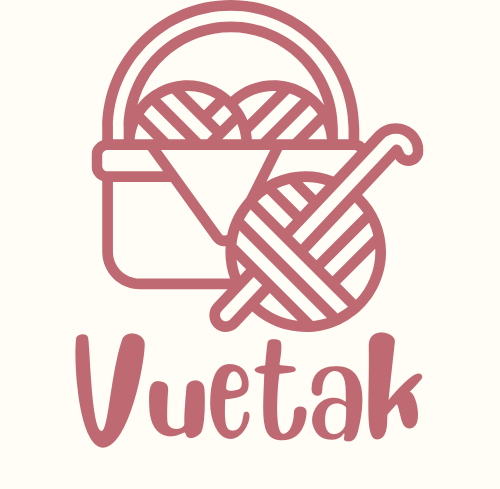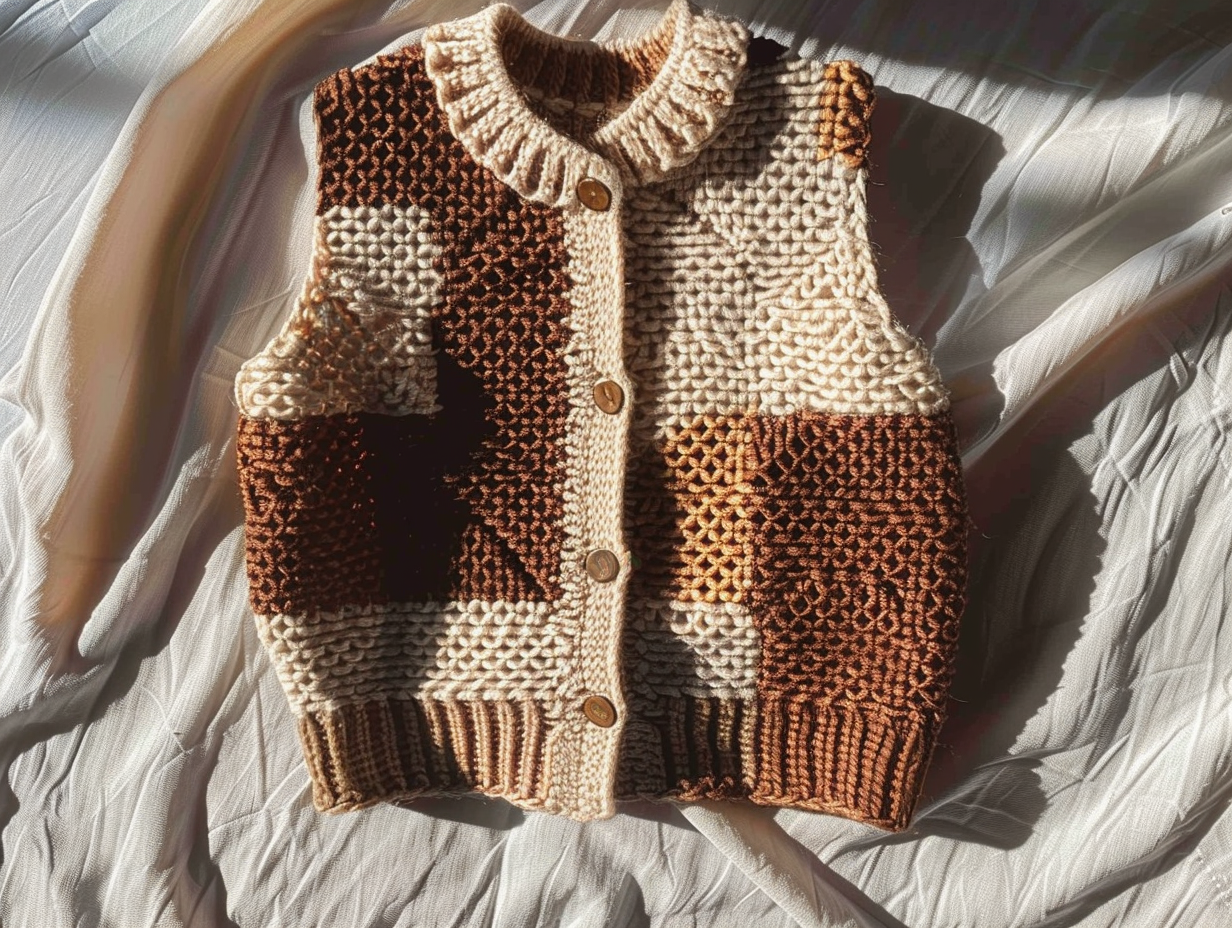Picture yourself wrapped in the perfect blend of vintage charm and contemporary style. This geometric crochet vest pattern brings together the best of both worlds with its striking intarsia colorwork design that’s been trending across social media platforms. The warm earth-tone palette of rich browns and creamy beiges creates visual interest through bold geometric blocks that shift and flow across the garment like a wearable piece of art.
This isn’t just another vest pattern – it’s a statement piece that showcases your crochet skills while delivering the kind of versatile layering piece every wardrobe needs. Whether you’re a confident intermediate crocheter ready to tackle colorwork or an advanced beginner looking for your next challenge, this geometric crochet vest pattern will expand your skills while creating something truly special.
Pattern Overview: A Modern Take on Classic Colorwork
This sleeveless vest features a sophisticated geometric design created through intarsia crochet techniques, where each color section is worked separately and joined seamlessly. The design consists of four distinct color blocks that create a dynamic, asymmetrical pattern across the front and back panels.
The construction method uses single crochet stitches throughout, making it accessible to crocheters who have mastered basic stitches but are ready to explore colorwork. The ribbed neckline, armholes, and hem add professional finishing touches while providing comfortable stretch and structure.
What makes this pattern particularly appealing is its modern interpretation of vintage aesthetics. The geometric blocking recalls 1970s fashion while the clean lines and contemporary fit make it perfectly suited for today’s layered looks. The sleeveless design makes it an ideal transitional piece for spring and fall, while also serving as a stylish layering option over long-sleeve shirts or under jackets.
The intermediate skill level stems from the colorwork technique rather than complex stitches, making it an excellent project for building confidence with intarsia methods. Most crocheters can expect to complete this vest in 15-20 hours, depending on size and personal working speed.
Complete Materials List
Yarn Requirements:
- Main Color A (Cream/Beige): 3-4 skeins of worsted weight yarn (approximately 450-600 yards)
- Main Color B (Medium Brown): 3-4 skeins of worsted weight yarn (approximately 450-600 yards)
- Accent Color C (Dark Brown): 1-2 skeins of worsted weight yarn (approximately 150-300 yards)
Recommended yarn: 100% acrylic or cotton blend worsted weight yarn for easy care and durability. Consider brands like Red Heart Super Saver, Lion Brand Vanna’s Choice, or Caron Simply Soft for consistent tension and beautiful color saturation.
Hook Sizes:
- Size H/8 (5.0mm) for main body construction
- Size G/6 (4.0mm) for ribbing details
Essential Notions:
- Tapestry needle for weaving in ends and seaming
- Stitch markers (at least 6 for marking color changes)
- Measuring tape for checking gauge and fit
- Small scissors for cutting yarn
Optional Supplies:
- Blocking mats and T-pins for professional finishing
- Row counter to track pattern repeats
- Yarn bobbins for managing multiple colors
- Steam iron for pressing seams (if using natural fibers)
Sizing & Fit Guide
This vest is designed with a relaxed, slightly oversized fit that layers beautifully over fitted tops or under cardigans and blazers.
Finished Measurements:
- XS/S: 32-34″ bust, 20″ length
- M/L: 36-38″ bust, 21″ length
- XL/2X: 40-42″ bust, 22″ length
- 3X/4X: 44-46″ bust, 23″ length
Size Selection Tips: Choose your size based on your actual bust measurement plus 2-4 inches of positive ease for the intended relaxed fit. The geometric design works best with this looser silhouette, allowing the colorwork pattern to display properly without distortion.
For a more fitted look, select one size smaller than your usual size, but note that this may affect the proportions of the geometric design. The ribbed edges provide some stretch and forgiveness in fit.
Gauge Importance: Achieving correct gauge is crucial for both fit and pattern alignment. Work a 4″ x 4″ gauge swatch in single crochet using your main color and Size H/8 hook. You should achieve 14 stitches and 16 rows per 4 inches. If your gauge is too loose, try a smaller hook; if too tight, use a larger hook.
Detailed Technique Breakdown
This pattern showcases intarsia crochet, a colorwork technique where each color section is worked with its own ball of yarn, creating clean color transitions without carrying unused colors across the work.
Primary Techniques Used:
- Single Crochet (sc): The foundation stitch for the entire garment
- Chain Stitch (ch): For turning and foundation chains
- Post Stitches: Front and back post double crochet for ribbing texture
- Intarsia Colorwork: Managing multiple colors within rows
- Seamless Construction: Working pieces separately then joining
Skill-Building Opportunities: This pattern provides excellent practice in color management, yarn tension consistency across multiple colors, and professional finishing techniques. You’ll master the art of twisting yarns at color changes to prevent gaps and learn to maintain even tension when switching between colors.
Prerequisites for Success:
- Comfortable with single crochet and basic increases/decreases
- Understanding of front and back post stitches for ribbing
- Ability to read written patterns and follow charts
- Basic seaming and finishing skills
Complete Step-by-Step Pattern Instructions
Abbreviations
- ch = chain
- sc = single crochet
- dc = double crochet
- fpdc = front post double crochet
- bpdc = back post double crochet
- inc = increase (2 sc in same stitch)
- dec = decrease (sc2tog)
- st(s) = stitch(es)
- sk = skip
- sl st = slip stitch
Special Techniques
Color Change Method: When changing colors within a row, complete the last stitch of the current color until 2 loops remain on hook. Yarn over with new color and pull through both loops. This creates a clean color transition.
Intarsia Yarn Management: Use separate balls or bobbins for each color section. Twist yarns at color changes by bringing the new color under and around the previous color to prevent gaps.
Gauge
14 sc and 16 rows = 4″ (10cm) using Size H/8 hook
Back Panel
Foundation: Using Color A, ch 58 (62, 68, 72).
Row 1: Sc in 2nd ch from hook and in each ch across. Turn. [57 (61, 67, 71) sc]
Rows 2-8: Ch 1, sc in each st across. Turn.
Color Pattern Setup (Row 9): Begin following the geometric chart. The back panel features a diagonal color transition from lower left to upper right.
- Rows 9-24: Work in established pattern, changing colors according to chart
- Rows 25-40: Continue geometric pattern with Color B dominant
- Rows 41-56: Complete pattern with Color A sections
Armhole Shaping: Row 57: Sl st across first 5 sts, ch 1, sc in next 47 (51, 57, 61) sts, leave remaining 5 sts unworked. Turn.
Rows 58-72: Continue in pattern, working straight with no further shaping.
Front Panel
Work same as back panel through Row 56.
Armhole and Neckline Shaping: Row 57: Sl st across first 5 sts, ch 1, sc in next 47 (51, 57, 61) sts, leave remaining 5 sts unworked. Turn.
Rows 58-65: Work straight in pattern.
Neck Shaping (Row 66): Sc across first 18 (20, 23, 25) sts, ch 1, turn, leaving remaining sts unworked.
Rows 67-72: Continue on these sts only for right shoulder.
Return to Row 66, sk center 11 (11, 11, 11) sts, rejoin yarn and work left shoulder to match.
Finishing
Seaming: Using tapestry needle and matching yarn, sew shoulder seams using mattress stitch for invisible joins.
Ribbed Edging: Using Size G/6 hook and Color C:
Neckline: Working around neck opening, fpdc around next st, bpdc around next st repeat around. Join and fasten off.
Armholes: Work same ribbing pattern around each armhole opening.
Bottom Hem: Work ribbing across bottom edge of vest.
Blocking: Lightly steam block or wet block to measurements, paying special attention to keeping geometric lines straight and even.
Customization & Variation Ideas
Transform this versatile pattern to match your personal style with these creative adaptations:
Color Palette Alternatives:
- Ocean Vibes: Navy, cream, and seafoam green
- Autumn Harvest: Burgundy, golden yellow, and burnt orange
- Modern Neutrals: Charcoal, cream, and soft gray
- Bold Brights: Fuchsia, turquoise, and sunny yellow
Seasonal Modifications: Add sleeves for cooler weather by picking up stitches around armholes and working in rounds. For summer versions, use cotton yarn and consider adding side slits for improved airflow.
Style Variations:
- Cropped Version: Stop at Row 45 for a trendy cropped silhouette
- Tunic Length: Add 15-20 additional rows for a longer, more covering fit
- Asymmetrical Hem: Create visual interest with an angled bottom edge
Skill Level Adjustments: Beginners can simplify by using just two colors instead of three, while advanced crocheters might add cable panels or textured stitches within the color blocks.
Styling & Usage Suggestions
This geometric vest transitions seamlessly from casual to professional settings. Layer it over a fitted white button-down for office wear, or pair with a flowing tunic and jeans for weekend comfort.
The earth-tone palette complements autumn and winter wardrobes beautifully, while the sleeveless design makes it perfect for transitional seasons. Consider it as a sophisticated alternative to traditional cardigans or as a unique layering piece under blazers.
The geometric pattern makes it an excellent conversation starter and artistic statement piece. It photographs beautifully for social media and works equally well for professional headshots or casual lifestyle photos.
Skill Level Assessment
Difficulty Rating: Intermediate
Required Prerequisites:
- Solid foundation in basic crochet stitches
- Comfort with following written patterns
- Basic understanding of garment construction
- Willingness to learn intarsia techniques
Estimated Completion Time: 15-20 hours
Learning Opportunities: Master professional colorwork techniques, improve tension consistency, and develop skills in garment finishing and blocking.
Project Applications
Personal Wardrobe Enhancement: Add a unique, handmade statement piece that showcases your crochet skills while providing practical layering options for multiple seasons.
Gift-Giving Potential: Perfect for fashion-conscious friends, art teachers, or anyone who appreciates handmade craftsmanship. The sophisticated design appeals to diverse age groups and style preferences.
Skill Development Journey: Use this project as a stepping stone to more complex colorwork patterns like fair isle or tapestry crochet. The techniques learned here translate directly to sweater and cardigan construction.
Creative Business Opportunities: The unique design and contemporary appeal make this an excellent pattern for craft fair sales or custom order work. Consider offering it in multiple colorways to appeal to different customer preferences.
Ready to create your own geometric masterpiece? This crochet vest pattern combines the perfect balance of challenge and achievability, resulting in a garment you’ll treasure for years to come. Whether you’re expanding your technical skills or adding a distinctive piece to your handmade wardrobe, this pattern delivers both learning opportunities and stunning results.


